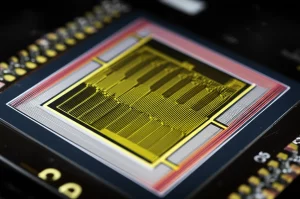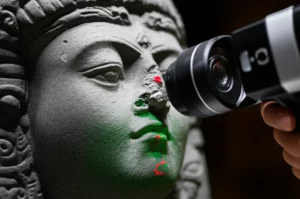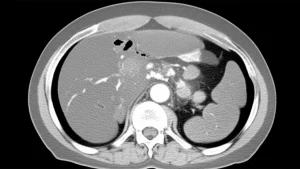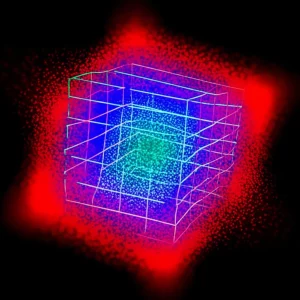Seeing the Unseen: Endoscopic Light Reveals Secrets of Tiny Drug Capsules
Hey there! Let’s talk about something super cool happening at the tiny scale. Imagine trying to build miniature medicine carriers – like microscopic capsules that can deliver drugs right where they’re needed in your body. Sounds like science fiction, right? Well, it’s becoming science fact, and a big part of making it work is being able to *see* and *understand* these tiny things really, really well, especially when they’re doing their job in a watery environment, kind of like inside you.
Now, these aren’t just simple spheres. The ones we’re interested in, especially for making them “smart” or “responsive” to light (which is key for things like targeted delivery or even therapy), can be quite complex inside. Think of them as having internal structures or properties that aren’t uniform. And studying them one by one, rather than in a big clump, gives us way more detailed info. It’s like trying to understand people by looking at a crowd versus talking to each person individually. Single-particle studies are just *better* for figuring out all the quirks and unique characteristics.
The Challenge of Seeing Small
Okay, so we need to study single, complex nanoparticles in liquid. What tools do we have? Optical tweezers are fantastic! I mean, seriously, they use light beams to grab and hold onto a single tiny particle. It’s like having microscopic tweezers made of light. This lets us hold a particle steady while we poke and prod it with other light or tools. Plus, you can do it in a natural, liquid environment, away from annoying surfaces that might mess things up.
For seeing tiny details, especially on the nanoscale, dark-field imaging is a go-to technique. Instead of shining light *through* the particle and looking at the shadow (like a regular microscope), dark-field shines light from the side. You only see the light that *scatters* off the particle. The background stays dark, making the tiny particle pop out like a star in the night sky. It’s great for seeing things smaller than the wavelength of light.
But here’s the hitch: traditional dark-field setups, especially when combined with optical tweezers, have limitations. The way they shine the light often means you can only collect the scattered light from a limited range of angles. If your particle has a complex inner life or is anisotropic (meaning its properties, like how it interacts with light, depend on which direction you look at it), you might miss crucial details in how it scatters light. Imagine trying to understand a sculpture by only looking at it from a narrow slit – you wouldn’t get the full picture!
Enter the Endoscope!
This is where our new approach comes in, and I think it’s pretty clever. We’ve integrated dark-field imaging into our optical tweezer setup in a totally different way. Instead of using fancy mirrors or cones to shape the light from above or below, we use a tiny optical fiber. Think of it like a miniature endoscope, but for light!
We dip this single-mode fiber right into the liquid where the particle is trapped. The fiber tip is bent, so it can shine light directly onto the trapped particle from the side, at a really high angle – almost 90 degrees relative to the microscope’s main axis.

Why is this so cool?
- Disentangled Paths: Because the illumination comes from the side via the fiber, it’s completely separate from the path where we collect the scattered light.
- High NA Collection: This means we can use a high Numerical Aperture (NA) objective lens – the part of the microscope that collects light – to gather the scattered light from a *much* wider range of angles. We capture way more information about how the particle scatters light.
- No Substrate Issues: The optical trap holds the particle high up in the liquid, far away from the bottom surface of the container. This eliminates any annoying interference or effects from the substrate, which is super important for studying particles in a realistic, “in situ” environment.
- Controlled Illumination: We can precisely control the polarization of the light coming from the fiber and know exactly how it’s hitting the particle.
This setup basically lets us get a much more complete “picture” of the particle’s optical response.
Meet Vaterite: Our Tiny Test Subject
To really test this new method, we needed a particle that was relevant to biomedical applications and also optically interesting – something with a bit of complexity. We chose vaterite capsules.
Vaterite is a form of calcium carbonate (yes, like chalk or seashells!). It’s particularly interesting because it’s:
- Porous: This means it has lots of tiny holes, making it great for loading up with drugs.
- Easy to Make: It can be synthesized quite simply and cheaply.
- Biocompatible: It’s generally safe to use in biological systems.
- Optically Anisotropic: This is key! Its optical properties depend on its crystal orientation. This anisotropy is useful for things like making particles rotate using light, which could be used for mixing fluids on a tiny scale or controlling drug release.
So, vaterite is a prime candidate for making those smart, optically-responsive drug delivery capsules I mentioned. But because of how it self-assembles, individual vaterite particles can vary in shape and internal structure. That’s why studying them one by one with a powerful tool is so important.
We used vaterite particles of different sizes, around 1 micrometer and 3 micrometers in diameter, for different parts of the study. We even managed to image particles as small as 250 nanometers!
What We Saw: Spectroscopy and Anisotropy
First, we trapped a vaterite particle using the optical tweezers. The trap itself helps align the particle based on its optical properties and the laser’s polarization. Then, we used our endoscopic fiber to shine white light on it and collected the scattered light with the high-NA objective, sending it to a spectrometer.
What did we find? The dark-field spectra – basically, a graph showing how much light is scattered at different colors (wavelengths) – changed significantly depending on the particle’s orientation! This confirmed that vaterite is indeed strongly anisotropic and that our setup could clearly see this directional difference in its optical response. This is much harder to do with standard dark-field methods because their illumination cones can excite multiple orientations at once, blurring the picture. Our method, with its fixed, high-angle illumination and controlled particle orientation in the trap, avoids this problem.
The Really Cool Part: Photonic Nanojets!
While looking at the slightly larger vaterite particles (around 3 micrometers), we saw something unexpected and fascinating in the images: photonic nanojets!

What’s a photonic nanojet? When light hits a particle of a certain size and refractive index, it can create a super-focused, intense spot of light just beyond the particle’s surface. It’s like a tiny, powerful light beam created by the particle itself. These nanojets are *near-field* phenomena, meaning they exist very close to the particle and usually don’t travel far. Seeing them directly with a standard microscope is typically impossible; you usually need special near-field microscopes or tricks to make them visible in the far-field image.
But with our endoscopic illumination setup, shining light at that ultra-high angle and collecting scattered light with the high-NA objective, we could see these nanojets directly in the microscope images! This was pretty exciting because it’s not something you’d normally expect to see in a standard far-field image.
Jets That Bend and Blink
We observed several cool things about these nanojets from vaterite:
- Orientation-Dependent: Just like the scattering spectra, the nanojets’ intensity and shape depended on the orientation of the anisotropic vaterite particle relative to the incident light polarization. We could rotate the particle in the trap and watch the jet change!
- Nanojet Blinking: When we rotated the vaterite particle continuously (using circularly polarized light in the trap), the nanojet appeared to “blink” on and off as the particle’s orientation changed. This blinking could potentially be used as a way to measure the particle’s rotation speed directly!
- Jets That Bend: This was perhaps the most surprising observation. When we brought a second particle close to the one generating the nanojet, the jet seemed to bend and point towards the nearby particle! This suggests a way particles can interact optically over intermediate distances.
Understanding the Bending Trick
Seeing the jet bend towards another particle was intriguing. Was the light field *really* bending in the near-field? To figure this out, we ran detailed computer simulations. We modeled the light interacting with two particles under conditions similar to our experiment, calculating the electromagnetic fields both very close to the particles (the near-field) and what the microscope objective would collect and turn into an image (the far-field or “lens view”).
Here’s the fascinating part: The simulations showed that in the *true* near-field maps, there was no bending of the jet towards the second particle. The jet stayed straight. However, when we simulated what the high-NA microscope objective would *see* and form into an image from that scattered light, the bending *appeared*!

This means the bending isn’t a physical bending of the light field itself in the near-field, but rather an effect of how the microscope objective collects the scattered light from both particles and forms the final image. It’s an artifact of the image formation process, but a very interesting one that shows how near-field interactions can be “mapped” into visible far-field phenomena under the right conditions. We also saw this bending effect with other types of particles, like silica spheres, though the jets from anisotropic vaterite were stronger and more confined.
Why This Matters
So, why is all this important?
- Better Particle Characterization: This endoscopic dark-field method gives us a powerful new way to study single nanoparticles, especially complex and anisotropic ones like vaterite, in a realistic liquid environment. We can see their optical properties from many angles and understand how their internal structure affects how they interact with light.
- Direct Nanojet Visualization: Being able to see photonic nanojets directly is a big deal. It opens up possibilities for studying these fascinating light phenomena and how they might be used, for example, to enhance sensing or manipulate other tiny objects.
- Understanding Optical Interactions: The bending phenomenon, even if an imaging artifact, highlights how particles can influence each other optically and how that interaction manifests in what we see through a microscope. This is important for understanding how particles behave in crowded environments.
- Fast Screening for Drug Delivery: For developing those vaterite drug capsules, this method allows for rapid screening and characterization of individual particles. We can quickly check their optical properties, see if they generate the desired nanojets, and understand how variations in their structure affect performance. This speeds up the design and optimization process significantly.
Standard characterization methods often just can’t keep up with the need for fast, detailed analysis of these complex nanodevices. This new endoscopic approach provides a much-needed tool.
Wrapping Up
In a nutshell, we’ve developed and demonstrated a novel endoscopic dark-field illumination technique integrated with optical tweezers. It lets us trap single particles, illuminate them from a unique high angle, and collect scattered light with unprecedented angular range. We used it to study vaterite capsules, confirming their strong optical anisotropy and, excitingly, directly visualizing photonic nanojets and a peculiar nanojet bending effect caused by the imaging process. This method is a game-changer for understanding the optical behavior of individual nanoparticles and offers a powerful platform for screening and optimizing next-generation biomedical nanodevices like optically-responsive drug delivery capsules. It’s pretty cool to think about how shining a light in just the right way can reveal so much about the tiny building blocks of future medicine!
Source: Springer





![Immagine fotorealistica di una scansione PET cerebrale che mostra l'attività della P-glicoproteina alla barriera emato-encefalica, con il tracciante [18F]MC225 evidenziato, obiettivo 50mm, alta definizione, illuminazione drammatica per enfatizzare i dettagli scientifici.](https://scienzachiara.it/wp-content/uploads/2025/05/043_immagine-fotorealistica-di-una-scansione-pet-cerebrale-che-mostra-lattivita-della-p-glicoproteina-alla-barriera-emato-encefalica-con-il-274x300.webp)

